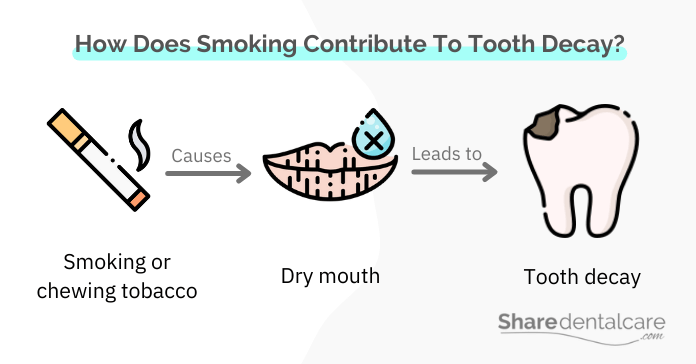Smoking not only affects your lungs and respiratory system but also can cause oral health problems. Researchers found a higher risk of developing gum disease, tooth decay, and oral cancer among smokers. Smoking can also dry out your mouth, leading to bad breath. If you are a smoker, it’s important to be aware of these risks and take steps to reduce your risk of oral health problems. In this blog post, we’ll discuss how smoking can damage your teeth and gums and provide some tips for reducing the risk.
How Can Smoking Damage Your Teeth?
Many oral health problems occur due to poor oral hygiene and dental plaque. Plaque is a sticky, colorless film of bacteria that forms on the teeth. If not removed regularly, it hardens into tartar. Saliva helps to wash away plaque before it hardens into tartar. Smoking can damage your teeth and gums because it reduces saliva levels in your mouth. We will discuss in detail how tobacco affects smokers’ teeth and gums.
Tooth Decay
Plaque bacteria decompose carbohydrates in the food you eat, and this process produces acid. The acids attack the enamel on your teeth, causing tooth decay. Over time, the decay can reach the inner layers of your teeth (tooth pulp), causing pain, dental abscess, and even tooth loss. Smoking can damage your teeth and cause tooth decay by drying out your mouth.
Saliva plays an important role in keeping your mouth healthy because it:
- Washes away food and plaque from the surface of your teeth.
- Reduces the number of bacteria in your mouth.
- Buffers acids produced by plaque bacteria.
- Contains calcium and phosphate, which helps to rebuild teeth enamel.
So, smoking means the plaque on your teeth will not be removed as fast. Without saliva to wash it away, smoking can lead to tooth decay and damage by leaving food residue in the mouth for a longer time. Read more about tooth decay from smoking.

Gum Disease
Gum disease, also known as periodontal disease, is an infection of the gums and bones around your teeth. Plaque bacteria break down carbohydrates and produce acids that irritate your gums, causing gingivitis. Gingivitis infection is a mild form of gum disease that can cause redness and swelling of gum tissues. If gingivitis is not treated, it can progress to periodontitis, an advanced form of gum disease. Smoking and gum disease can damage your teeth by destroying the tooth-supporting tissues, which can cause tooth loss.
Smokers have twice the risk of developing gum disease than non-smokers, and smoking is a major risk factor for developing severe forms of gum disease. Smoking can damage your teeth and increase your risk of gum disease by causing the following:
- The chemicals in cigarettes irritate your gums and make them more susceptible to infection.
- Tobacco smoking reduces the amount of saliva in your mouth, which washes away plaque and bacteria from the teeth surfaces.
- Smoking reduces the blood flow to your gums, making it difficult for your body to fight infection.
- Gum disease treatment may not work as well for smokers because smoking slows the blood circulation in the mouth. Read more about the effect of smoking after oral surgery.
If you are a smoker, it’s important to quit smoking and visit your dentist regularly for checkups. This will help you prevent smoking damage to teeth and gums and detect problems early. Read more about gum disease from tobacco.
Teeth Stains
Smoking can also affect the appearance of your teeth by leaving stains on them. The nicotine in cigarettes and other tobacco products can cause teeth to become yellow or brown. Over time, the enamel on your teeth may wear away, exposing the dentin underneath, which has a darker color. The stains are hard to remove with regular tooth brushing. You need to visit your dentist for treatment. The treatment depends on the severity of stains, which includes OTC whitening toothpaste, teeth whitening (at home or in the office), or veneers (composite or porcelain). Read more about how smoking makes your teeth yellow.

Smoking Not Only Can Damage Your Teeth But Also Cause Health Problems
Both smoking and gum disease are risk factors for other health problems. Smoking increases your risk of developing heart disease, stroke, and lung cancer. Gum disease is linked to serious health problems such as heart attack and stroke.
If you are a smoker, quitting smoking not only helps to prevent smoking damage to teeth and gums but also other smoking-related health problems.
Prevention of Teeth Damage Caused by Smoking
There are several things you can do to reduce your risk of smoking damage to teeth and gums:
- Quit smoking. If you can’t quit smoking, reduce the number of cigarettes you smoke.
- Brush your teeth at least twice daily with fluoride toothpaste.
- Floss daily to remove plaque from between teeth.
- Drink plenty of water to keep your mouth moist and help flush smoking chemicals out of your system.
- Limit your consumption of high-carbohydrate foods such as candy, cookies, and soft drinks.
- Visit your dentist regularly for checkups and professional teeth cleaning.
Read more about smokers’ gums treatment.
Smoking Damage to Teeth – Conclusion
Smoking can cause several serious health problems, including heart disease, stroke, and lung cancer. Smoking can also damage your teeth because it reduces saliva levels in your mouth, which increases the risk of tooth decay and gum disease. There are several things you can do to reduce your risk of smoking damage to teeth and gums, including quitting smoking, brushing your teeth twice a day with fluoride toothpaste, and flossing daily. Also, visit your dentist regularly for checkups and professional teeth cleaning. Quitting smoking not only helps to prevent smoking damage to teeth but also other smoking-related health problems.